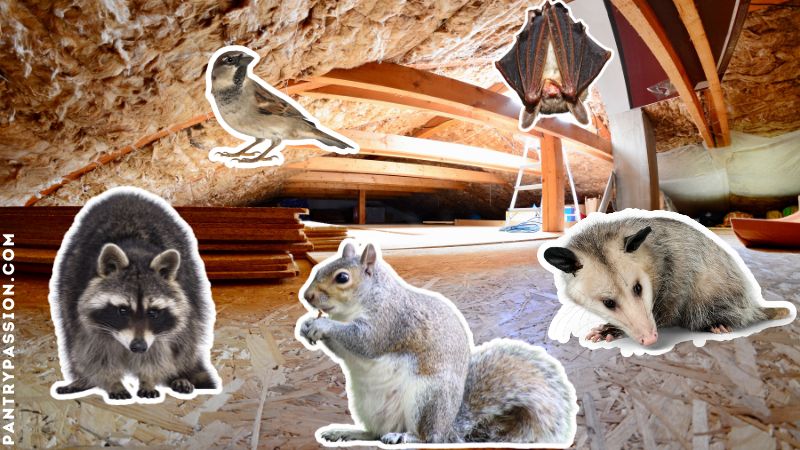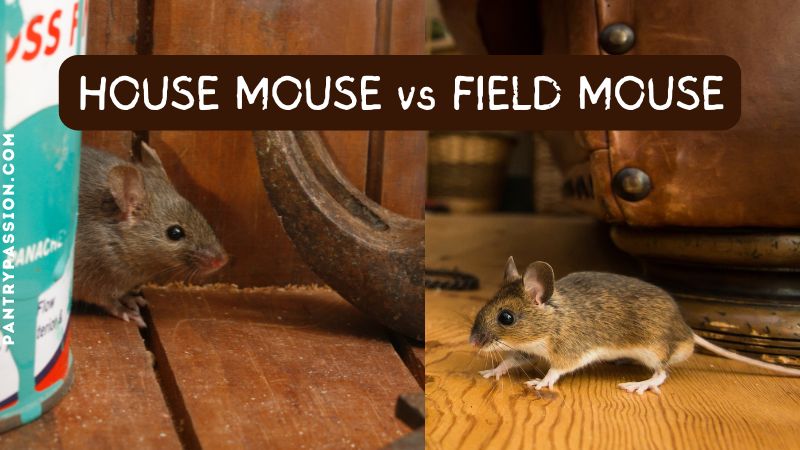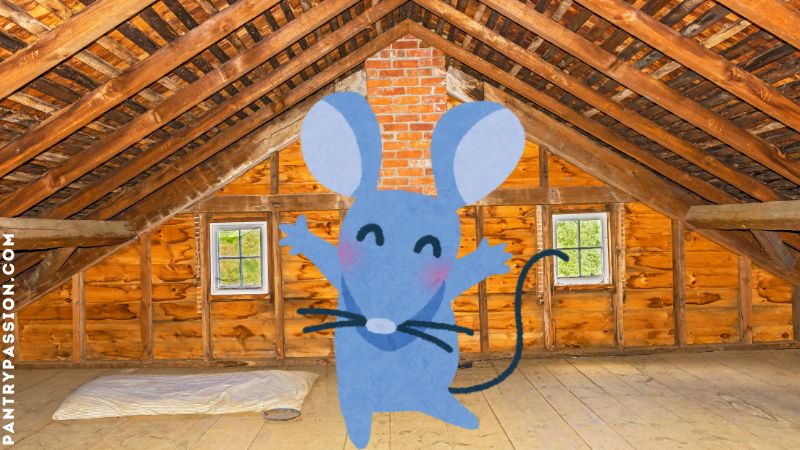The Best Fluffy Pancakes recipe you will fall in love with. Full of tips and tricks to help you make the best pancakes.

Scratching sounds in your house… in the middle of the night… coming from your walls and attic… is THE WORST! It means you have a mouse or rat problem to face if you’re hearing sounds of mice in walls. You don’t know how bad those rodents have dug in and where to begin.
Whether you’re dealing with a full-blown infestation or just a few curious visitors, we’ve got attic-tested tips to help you reclaim your space and restore your peace of mind. Once inside, they’ll burrow into insulation, chew through wires, and set up cozy nests like they own the place.
Let’s consider those signs and sounds and figure out what to do about it. Who knows, it might not even be mice, but something else…
DON’T MISS Pantry Passion’s Complete Article List for Mouse & Rat Prevention!
Table of Contents
- What Do Mice Sound Like in Attic & Walls?
- What Other Animals Could Be in My Attic?
- Look for These Other Signs of Mice
- How Do Mice Get Into the Attic?
- Can Mice in Attic Get into House?
- Mice in the Attic With “No Access”
- Can Thermal Imaging Find Mice in Walls?
- Other Options to See Mice in Attic: Cameras
What Do Mice Sound Like in Attic & Walls?
Sounds are often the first sign of a problem. Mice are small, but their tiny feet, claws, and teeth make surprisingly audible noises—especially in quiet nighttime hours. If you’re hearing faint rustling, scratching, or squeaking above your ceiling, it’s time to investigate.
Mice make a variety of sounds depending on what they’re doing:
- Scratching: As they climb, dig, or chew through insulation and wood.
- Scurrying/Rustling: Quick, light footsteps across beams or drywall.
- Gnawing: A soft grinding or crunching sound as they chew wires, boxes, or wood.
- Squeaking: High-pitched vocalizations, especially when communicating or startled.
Others describe sound of mice in walls as scraping, running, and even playing. Materials like plaster, wood, and wires give the rodents plenty to interact with. These noises are often amplified in attics, making them more noticeable than you’d expect.
Erdye’s Pest Control makes a great video on how to discern between different animals sounds. He said if you sense the sounds feel like an animal ready to burst through your ceiling or wall – that’s going to be a larger animal, like a racoon or squirrel.
Mice and rats are most active after dark because they are nocturnal animals. when the house is quiet and they feel safe to explore. If you hear movement overhead between 10 PM and 4 AM, it’s a strong clue. They may be involved in the activities of nesting, and foraging.
Mice don’t just stay in the attic—they often use walls as highways, moving between floors and rooms. If you hear scratching in the walls followed by attic activity, you’re likely dealing with a full-house infestation. Look for droppings, chewed materials, or greasy rub marks near baseboards and vents.

Sounds in The Attic: My Story
Many years ago, I heard a strange sound above the ceiling in my child’s nursery. It didn’t fit the category of any of the example sounds above. It was a more “writhing” or squirming sound concentrated in one spot, like the animal might have been dying.
We didn’t have traps in our attic, but we would toss poison packs up there. That attic was also very difficult to get into, so we never did explore. Now I feel that it was either a rat or squirrel dying, although we never smelled a decomposing dead animal. It remains a mystery to this day!
What Other Animals Could Be in My Attic?
Scratching in the attic doesn’t always mean mice. It could be other animals in your attic.
Several animals besides mice and rats seek shelter in attics during winter—especially in colder regions like central and northern United States. Your attic offers warmth, safety, and nesting material, making it a prime target for wildlife trying to escape the cold.
Animal in Attic Sounds
| Animal | Signs of Presence | Risks & Concerns |
|---|---|---|
| Squirrels | Daytime scratching, fast scurrying sounds, erratic movement | Chew wires, insulation damage, fire hazard |
| Raccoons | Heavy thumping, growling, nighttime activity | Structural damage, disease risk, aggressive if cornered |
| Bats | Chirping, fluttering, droppings (guano) | Health risks (histoplasmosis), protected species laws |
| Opossums | Slow movement, chirping, hissing, scratching at night | Messy nests, odor, parasites |
| Birds | Chirping, flapping, nesting materials | Droppings, mites, blocked vents |
| Snakes | Silent, shed skins, droppings | Rare but possible—follow rodents into attics |
| Insects | Buzzing, crawling, visible nests | Wasps, bees, stink bugs, cluster flies |
According to Erdye’s Pest Control, only bats make squeaking sounds. The fella below cleverly listened to Youtube videos to see if he could match his sound in the attic with other examples:
Reddit member Fun_Sea6481 shares their results: “I did hear them chattering yesterday and I compared it to noises I heard on YT, sounds similar enough… Update… user is correct, it is squirrels.”
Another practical tip from Drewski1999: “There will be droppings if there are mice or rats. If you can’t find droppings inside, check for droppings around the exterior foundation. They can’t take two steps [mice/rats] without defecating so you’ll find droppings. If you can’t find droppings it’s time to think of a larger animal… but just try to find droppings first. Cross reference the droppings with the internet and you’ll know what you have.”

Look for These Other Signs of Mice
Beyond sound, here’s what to look for:
- Droppings: Small, dark pellets near insulation or storage boxes.
- Rub trails: Rats are greasy, spotting their movement through holes and along walls is usually visible.
- Chewed wires or cardboard: A fire hazard and a clear sign of nesting.
- Nests: Shredded paper, fabric, or insulation balled up in corners.
- Musty odor: From urine or decomposing materials.
Is it rats or mice? Consider this:
Rat urine tends to have a stronger, more pungent odor due to larger volume and higher concentration. Rats produce more urine per day than mice because of their larger size. Rat urine leaves larger stains and may appear oily or greasy around entry points.
Mouse urine is milder but still musky, often described as slightly sweet or acrid. Mice urinate frequently in small amounts.
If you’re noticing strong odor and larger stains, it’s more likely a rat. If the signs are subtle and scattered, you might be dealing with mice.
How Do Mice Get Into the Attic?
Twin Home Experts on Youtube, recommend to go up into your attic, pull away the insulation from the dark parts of the edges. Then… here is the scary part… turn the attic lights off. This will easily reveal light getting in from the outside that identify pest entrances.
This of course, doesn’t explain everything. Tiny mice could be sneaking in among cracks around pipes.
Mice can definitely travel from the walls of your house into the attic, and it’s one of their favorite routes. They are surprisingly agile little creatures. Once inside your walls, mice can easily reach the attic—especially if there are gaps around vents, chimneys, or eaves. Their small size (they can squeeze through holes as tiny as a dime) and sharp claws make them expert climbers.
I’ve come across this information repeatedly: mice are unlikely to climb vinyl siding because it’s slippery. Thank goodness. If it’s stucco, you’re screwed.
Here’s how they do it:
- Climbing vines, cables, or rough brick: Mice are built for climbing.
- Roof gaps and soffit vents: Even the tiniest crack around your eaves or chimney can be an open invitation.
- Chimney
- Porches
- Probably the sewage/water pipes access holes
- Unsealed utility lines: Where wires or pipes enter your home, mice may follow.
- Overhanging tree branches: Think of them as rodent highways straight to your roof.
- Climbing inside wall cavities: Mice can scale vertical surfaces like drywall, pipes, and wiring chases. Install vent covers and chimney caps
- Following utility lines: Electrical wires and plumbing often run from the basement to the attic, giving mice a built-in highway.
- Gnawing through materials: They can chew through wood, drywall, and even PVC to create new paths if needed.
Rats are more likely to use the vegetation to climb. Along with squirrels or other critters. You should always cut all limbs and branches away that touch the house. I would also be suspect of the HVAC as a potential source if it’s a split unit and some of it is in the attic. Sometimes they travel along the lines connecting the outside part to the attic part.
Control vegetation along the side of the house- no vegetation touching the house- put in a gravel or concrete barrier 18” wide from house. Exterior bait stations are the best defense.
One seasoned pest control pro commented, “When I did mouse jobs, they got in through the basement, almost 100% of the time. Mice are also incredibly good climbers… depending on what material the outside of your house is (siding, brick, etc) they can climb up and get in through there. They can also get in through the roof of your house. Maybe through a tree branch, or by just straight up climbing the side of the house. There are so many ways.” Anonymous Reddit member
Can Mice in Attic Get into House?
Yes—mice in the attic can absolutely get into the rest of your house. In fact, the attic is often just a staging ground for a full-blown invasion. Here’s how and why it happens:
1. Wall Voids and Insulation Pathways
- Mice use wall cavities like highways, traveling vertically and horizontally between floors.
- Their small size and climbing ability let them squeeze through gaps in framing, insulation, and drywall.
2. Plumbing and Electrical Routes
- They follow pipes and wires that run from the attic to kitchens, bathrooms, and basements.
- These routes often have unsealed gaps that mice exploit.
3. Air Ducts and Vents
- While mice don’t typically live in ducts, they can use them to move between attic and living spaces.
- Gaps around ductwork or poorly sealed vents are common entry points.
4. Ceiling and Light Fixtures
- Mice can drop down through recessed lighting or ceiling cracks, especially in older homes.
- If you hear scratching above ceiling tiles or near light fixtures, this could be the route.
5. Structural Gaps and Construction Flaws
- Attics often connect to wall voids, soffits, and crawl spaces. Any construction gap becomes a mouse tunnel.
- Vines, cables, or tree branches touching the roof can also help mice reach attic entry points.
If you’re hearing scratching in the walls or ceiling, it’s time to act before they settle in. Seal gaps around pipes, vents, and wiring. Inspect attic insulation for nest or droppings. Set traps near suspected entry points and monitor for activity. Trim vegetation near the roofline to reduce access.
Mice in the Attic With “No Access”
“No access” doesn’t mean “no mice.” Homes with beautiful cathedral ceilings, and vaulted living room ceilings can succumb to mouse invasions. Even if the places seems sealed off, mice can find hidden entry points you’d never suspect:
- Behind walls, through crawl spaces, or via plumbing chases.
- Through foundation cracks that lead to wall voids and eventually the attic.
- Via air ducts or venting systems that aren’t properly screened.
If you’re hearing scratching but can’t find how they got in, it’s time for a flashlight, a ladder, and a little detective work—or better yet, a professional exclusion inspection.
Can Thermal Imaging Find Mice in Walls?
Ah, if it were only true. Most people will tell you to save your money on thermal imaging equipment to find mice. I see where you’re coming from, though.
Thermal imaging cameras (like FLIR) detect infrared radiation—essentially heat—emitted by objects. Mice, being warm-blooded, give off heat that can sometimes be picked up through walls if:
Thermal imaging probably isn’t the best tool for controlling rodent infestation. @oxfordpictionary commented on a Youtube video “Yes it can [work] but only if it is a nest they have spent time in for a while or where more than one congregates. Not for every individual mouse wandering through a wall.”
@hummervs3278 commented, “Been level 2 thermographer for some years now. Never once have I seen critters with the $30,000 camera from flir nor the $22,000 camera from fluke. Not saying it’s impossible.”
Thermal imaging challenges:
- Doesn’t “see through” walls: It only detects surface temperature differences caused by what’s behind the wall.
- Insulation can mask heat: Thick or blown-in insulation (like cellulose) can block or diffuse the heat signature.
- Low-end cameras may struggle: Budget thermal imagers (<$500) might not have the resolution or sensitivity needed for small rodents.
Other Options to See Mice in Attic: Cameras
Rigging up night vision cameras or even Ring cameras in your attic can reveal valuable information. If you don’t feel like you are getting on top of your attic pest infestation, give these camera a try.










